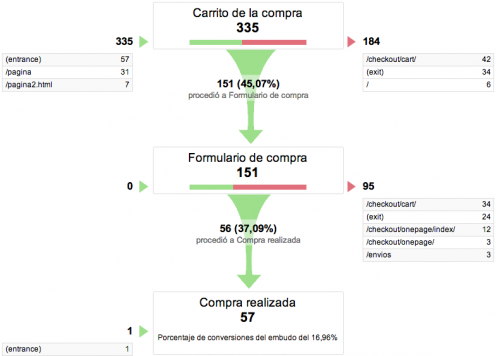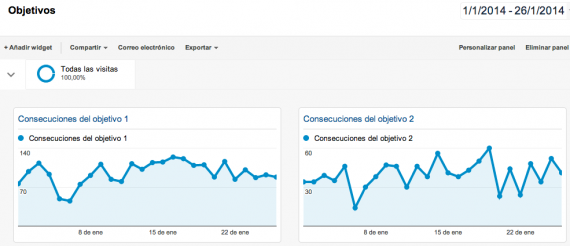Written by Jose Vicente
Índice
The analytics of our website must be correctly configured to be a tool to evaluate the performance of our online promotion actions and to be able to make decisions to improve them. For this to be possible, we must have the objectives configured in our analytics tools. The objectives of our website must be aligned with the quantitative and qualitative objectives of our business.
Analytics should allow us to evaluate the performance of our online promotion actions and be able to make decisions to improve them.
Depending on our business model and the section of our website we want to measure, we must configure appropriate objectives for each case. Within the same website, different levels of objectives can be established, but we will always have some main conversion objectives whose improvement must be a constant obsession. But the fact that we want to favor some main conversion objectives does not mean that we should neglect other qualitative ones. For example, in an e-commerce the main objective should always be to increase sales, but this can be supported with the achievement of other secondary objectives such as user loyalty, increasing the number of recurring users that can ensure minimum monthly sales.
Indicators to measure conversion in Google Analytics
Google Analytics offers many features that will help us to measure almost any goal we set for our online business. Let’s take a look at some of these.
Conversion targets
When we start reviewing the analytics of a website, this is the first section we usually check to assess the quality of the configuration. The fact that there are no targets configured on a website is an indication that there is still a lot of work to be done in terms of configuring the tool.
Some common examples of target settings on websites could be:
- Sending of data by the user: contact forms, quotation request forms, suggestion forms, newsletter subscription forms, etc. The sending of information by the user is usually recorded in Analytics with a target or event type objective.
- Qualitative objectives: this type is usually set with objectives of visit duration or page views. It is usually more interesting in sites with monetization by banner impressions, which does not detract from the fact that it can be established as a secondary objective in any other website where we want to improve the loyalty of our customers.
- Actions performed by the userIf there are certain actions of our users that are relevant to the objective of our site, such as downloading our catalog or the specifications of one of our products, it is highly recommended to record these actions with events and set them as event type objectives in our analytics.
Conversion funnels
The Google Analytics destination type goals offer the conversion funnels functionality that consists of configuring the list of pages that the user must go through to reach the conversion. The clearest example of a conversion funnel would be a shopping cart, where we would configure each of the steps the user goes through (cart, personal data, payment method, shipping method, etc.) until the purchase is completed. Although the conversion funnel graph allows us to see how many users go through each of the steps, the most important data of this indicator is to see at which step users tend to abandon the process. This would be a clear example of what the analytics of our site should bring us, quantify the users that convert and discover weak points of conversion losses.
E-commerce
When the analytics to be configured pertain to e-commerce, this is another critical point to review. Our site analytics must be able to relate the sales made in our e-commerce to the rest of the site analytics metrics.
It is not necessary to have an e-commerce to make use of this functionality. If, for example, the purpose of our site is to request quotations or requests for information on our product series, we can use this functionality to record statistics on the products that most interest our users, even if a sale has not been made.
Customized dashboards and reports
These functionalities are not an indicator as such, but they make our job easier when it comes to periodically reviewing our site’s indicators. It is highly recommended to always have a dash board that shows us at a glance the performance we are getting from our website. It also allows us to have indicators at hand that we cannot set as targets. For example, it allows us to have comparative or trend graphs of qualitative objectives such as the number of recurring users of our site or quantitative objectives such as the amount of traffic.
By having our objectives collected in a dashboard or customized report Analytics allows us to schedule periodic delivery to our email address. In complex sites, we can set up customized dashboards and reports with objectives and indicators by department and send to each of them only the most relevant indicators with their activity.
Measuring online from offline
When our web analytics tool does not allow us to correctly measure the objectives, we can sometimes resort to offline practices to measure the ROI of our website. If the main means of communication with our potential customers is the telephone, the most effective way to measure the contact requests obtained by our website is to have a telephone number dedicated exclusively to the website. By keeping a record of calls from this phone number we will have valuable statistics to evaluate the objectives of our website. If it is not possible to have a dedicated phone number, or we want to get more accurate data, a best practice is to ask each new contact request how they got our business phone number or how they found us.
In some cases, if the customer has doubts before making the conversion or our website puts some kind of barrier to the user to convert, usually resort to the phone to resolve the situation. Asking about the possible problems encountered when using our website is a relatively inexpensive usability study on a sample of users very interested in our business.
Our website must be built based on the objectives established in our online promotion plan.
Websites have long since ceased to be mere catalogs and have moved to the online world where we see a representation of products and services. A website must be created taking into account some objectives that must also be aligned with the strategy of our business. We will only be able to know the success or failure of our project if we have a properly configured web analytics that quantifies the objectives achieved. And in case the data is not as satisfactory as expected, analytics will help us understand the reasons why it has not worked and where we should start improving our website.
If you don’t know how to configure the goals of your website and you want to learn how to do it, you can sign up for our online course on how to configure web goals with Google Analytics.






